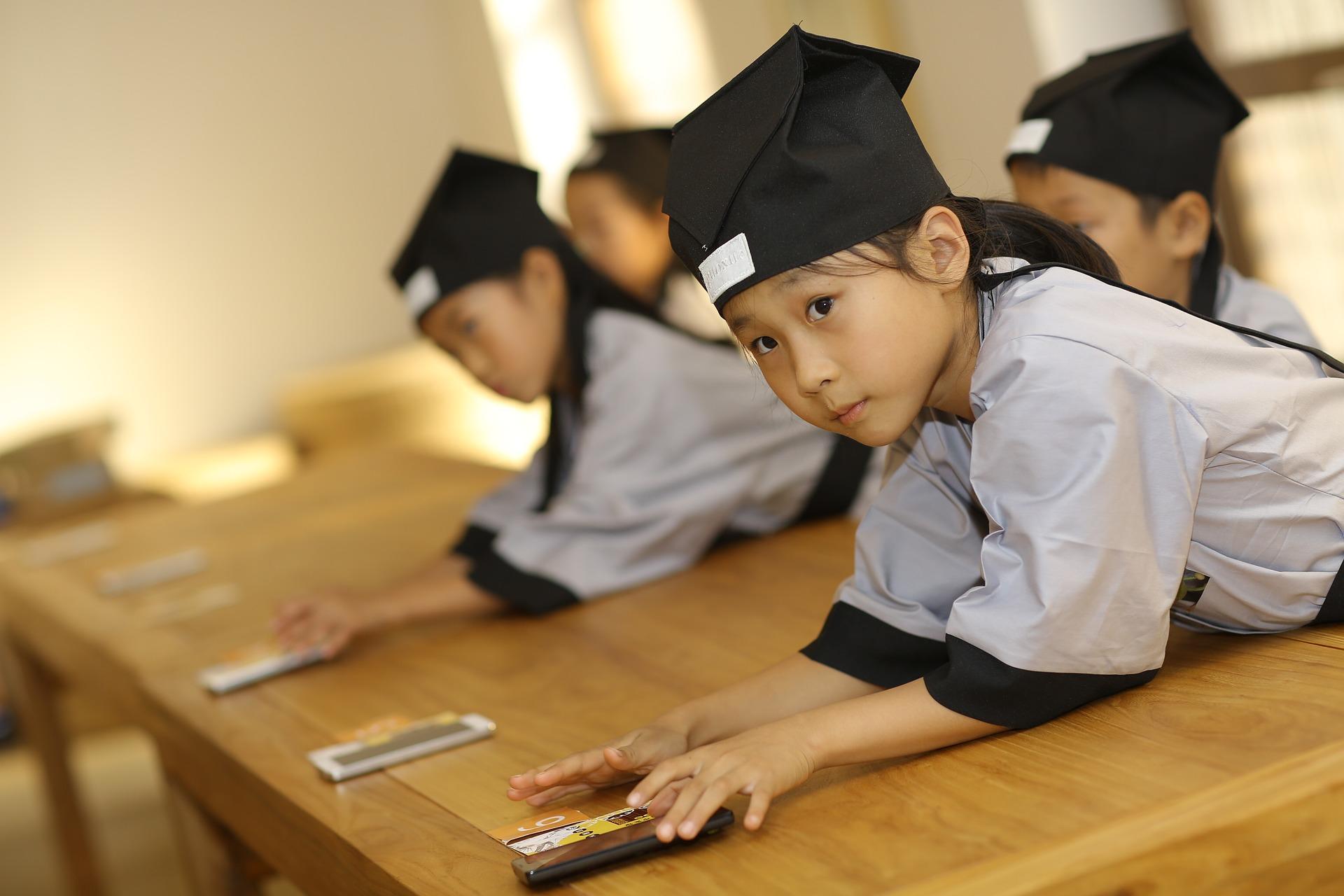In a group of three people, there will always be one person I can learn from.
~ Chinese Proverb ~
Learning a language is not only about the ability to speak and understand other speakers. There is written communication too — reading and writing — as well as cultural understanding. Unlike most European languages, learning to read and write in Chinese requires hours and hours of practice memorising the characters — there are 50,000 of them but take heart ... you only need to know 2000 or so to read a newspaper.
China has the fastest-growing economy in the world and Chinese, specifically Mandarin (the most commonly spoken of the ten regional dialects), has the second-highest number of native speakers in the world, after English.
It's no wonder that Chinese is listed as one of the sixteen recommended foreign languages in the Australian Curriculum for students in primary school and high school to Year 10.

Chinese Language Education in Australia
Students have been learning Chinese in schools since the 1950s and the language went through a bit of a boom period in the 1980s but then lost popularity shortly after. While there are still many more students learning French, Italian and Japanese at the moment, a slowly increasing number of schools are starting to offer Chinese as part of their languages program.

One of the reasons for the slow uptake of Chinese compared to other languages is an undersupply of qualified teachers with enough Chinese language ability to teach the curriculum and meet course outcomes.
Long gone are the days when language teachers could get by with teaching their students some basic greetings and colours, singing a few songs, handing out colouring sheets and culture research assignments and cooking fried rice and fortune cookies.
Language teachers these days have to be fluent or near-fluent in the language they are teaching — in all skill areas, including reading, writing, listening and speaking — and, preferably, have in-country experience. The curriculum demands this and so do the students.
The Chinese Language Curriculum in Australia
The Australian Curriculum lists 16 languages (or language groups) that are recommended for students from Foundation through to Year 10. There are 5 pathways:
- Second Language Learner (F-10)
- Second Language Learner (Year 7 entry)
- First Language Learner (Year 7 entry)
- Background Language Learner (F-10)
- Background Language Learner (Year 7 entry).
Learning Chinese (and other languages) does not stop at Year 10; however, for Years 11 and 12, each state is responsible for the curriculum based on their Year 12 leavers' exam process.
For simplicity, only the Second Language Learner pathways will be discussed here.
Learning Chinese in Primary School
During the primary school years, Foundation to Year 6 in most states, students of Chinese are mainly engaged in the oral side of Mandarin Chinese. Because the pronunciation of English and Chinese is quite different, especially with the addition of tones in Chinese, teachers spend a lot of time immersing students in the sounds and spoken words of China, its vocabulary and grammar.

Students engage in speaking and listening practice through a range of games, drama-based tasks, action-related talk and collaborative activities. Through this, they are exposed to essential grammar patterns, new vocabulary and basic phrases in context. Multi-media resources are used to train students' ears to the tones of Chinese pronunciation.
Reading and writing are incorporated as part of a whole-language and culture program. Students engage with picture books and simple texts relevant to the themes of study. They are introduced to some basic characters and also to the Pinyin system of romanisation for written texts.
Although it's not common in the early years, many students, particularly those of native-speaking background, end up engaging a private tutor to further extend their skills.
High School (Years 7 - 10) Chinese Lessons
Depending on your state, it is compulsory to study a foreign language for the first one or two years of high school. After this, foreign language study generally becomes an elective. Some schools allow students a choice of languages during the mandatory period, while others have students study all languages on offer as 'tasters' in the first year, with a choice being offered in the following year.

For students who are continuing with their Mandarin learning in Year 7, the curriculum continues to focus on oral language use with students required to speak and interact in increasingly complex scenarios. The emphasis is on longer periods of conversation, or language practice in quasi professional and more formal settings. Interaction with native speakers of Chinese is sought with more frequency.
When it comes to the written form of the language, as in primary school, Pinyin continues to be important for learning the sounds of new words, sound to character association and the creation of digital texts using characters. Many outcomes start to focus on reading and students are encouraged to develop strategies to comprehend texts written in characters when they come across unknown characters.
Unlike in many primary school lessons, where English is the main language of instruction — apart from basic directions like 'stand up' or 'open your books' — high school teachers often give instructions in Chinese.

Beginning or Continuing Chinese in Senior Secondary School
Only around ten per cent of Year 12 students study a language for their final year — compared with the more popular learning areas that were pulling in well over 70 per cent of enrolments. Of those students who do enrol in a language in their last year of school, Chinese is the most popular choice, followed closely by Japanese and French.
Generally speaking, students who elect to study Chinese in Years 11 and 12 are usually those who want to enrol in a Chinese degree, or major, at university and continue on to a career using their language skills.
Some, however, simply enjoy learning Chinese.
Discover an amazing Chinese course here on Superprof!

There are two pathways to studying a language at senior secondary level — beginner and continuing — and both can contribute towards your Year 12 certification and ATAR score. In fact, Chinese and Italian are considered to be good choices for both beginners and continuing students when it comes to Year 12 exam scaling.
Beginners and Continuing Chinese
The main difference between the beginners and continuers pathways is the level at which students start exploring the language. In terms of themes, however, these are not dependent on language level.
Language learners in Years 11 and 12 will generally explore three broad themes in the context of the language and culture they have chosen:
- the individual — cultural topics (education, leisure, relationships, etc.)
- the language community — aspects of history, culture and lifestyle
- the changing world — issues around social aspects, youth, environment and work.
As mentioned previously, however, the individual states control musch of the curriculum at the senior secondary level, with the exception of English, maths, science and social sciences, so language overviews will vary considerably.
Chinese for native speakers
Students who are bilingual, with their first language being Mandarin (or another dialect), learn instead about being bilingual in Australia and work towards developing their bicultural identities. All instruction is in Chinese and students present, discuss and debate topics with their peers as well as staff.
Of course, there is the issue of not all schools offering Chinese. Or perhaps you don't actually want to learn Chinese at school. Let's finish by looking briefly at in-country study and how to learn Chinese in a less formal education setting.
Studying In-country
There are language immersion programs (where your teacher conducts every lesson fully in Chinese and no English is spoken — until you leave the classroom) and then there is the full immersion of living and studying in China. Without a doubt, this is the best way to learn Mandarin, as well as pick up some of the other nine dialects.
You may be working in China and attending lessons after work or on weekends, or you may be living in China as a student and attending lessons for several hours a day. Either way, the fact that, outside of your lessons, everyone around you is speaking Mandarin Chinese — at the shops, in your neighbourhood, on the train — you are getting 24-hour oral and written comprehension practice and your improvement will be much faster than back in Australia surrounded by written English and English speakers.
Where and How to Learn Chinese Outside of Formal Education
Learning Chinese is not limited to formal school settings, university study or living in China. There are plenty of other options, including:
- Chinese community associations
- YouTube channels
- online study via an app or language website
- informal conversation classes and lessons
- language exchange with a Chinese student who wants English practice
- online language exchange with a person living in China.
If you do feel you want some structure but don't want to enrol in a formal lesson series, a private tutor of Mandarin may be just who you need. Private tuition is less rigid but still gives you structure with a focus on what you want to learn, be it pronunciation practice or how to read and write.















Excellent Blog! I really enjoyed reading it. I am a Chinese language teacher in Cairns. Thank you Kellie for your great work regarding Chinese language learning for Australians :)